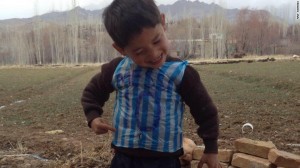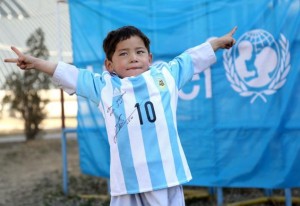Earlier this month, Lionel Messi’s jersey was trending on Facebook. No surprise there. The football star, often dubbed the best soccer player in the world,1 is used to turning heads. A forward for both the Argentine national team and FC Barcelona, Messi is a five-time recipient of the Ballon d’Or,2 a prestigious award that singles out the best player among all European football clubs.
But Lionel Messi’s 5’7” frame was missing from the jersey featured on Facebook. And the jersey3 itself was of the discount variety: a blue-and-white striped plastic bag with “MESSI” hand-written in dark blue ink. So why all this attention for a piece of plastic? The jersey’s equally humble origins shed some light on the surrounding Facebook frenzy.

“An image posted to Hamayon’s Facebook page shows his little brother dancing in his makeshift shirt.” Credit: Arif Ahmadi, courtesy of CNN.com.
Photographs of a young boy from Afghanistan wearing the homemade jersey went viral in January, prompting a search for his identity.4 The clues led to a small family farm in Afghanistan, the home of five-year-old Murtaza Ahmadi.4 CNN interviewed the boy’s father, Arif Ahmadi, who shared the story behind the jersey that caught the Internet by storm.4 Arif explained that the young footballer woke up during the night crying that he wanted to see Messi. He then started asking his father for a Messi jersey. Arif told CNN,
“I told him that we were living in a poor village far from the city and it was impossible for me to get him the shirt. He kept crying for days asking for the shirt until his brother Hamayon helped him make one from the plastic bag to make him happy. He stopped crying after wearing that plastic bag shirt.”4
The five-year-old’s story captured the attention of the United Nations Children’s Fund (UNICEF) and Messi himself.4 In new photos released in late February, Murtaza can be seen posing in a genuine Lionel Messi jersey with the soccer star’s signature.4 This jersey was just one of several sent to Afghanistan by UNICEF, along with a brand-new soccer ball to replace the punctured one Murtaza had become accustomed to playing with.5 Best of all, Lionel Messi is looking to meet the boy soon.6
Besides its obvious poignancy, Murtaza Ahmadi’s story tells us a lot about football in the contemporary context. Let’s start with the economics of the Argentine jersey. While Murtaza’s makeshift jersey probably cost under a penny, an official Adidas Lionel Messi Argentina home jersey sells for $119.99 on soccer.com.7 Why the steep price? For one, it sells. Whether you are walking on the streets of Buenos Aires or Barcelona, you will undoubtedly find fans proudly donning authentic Argentinian national team merchandise or sporting the well-known “Més que un club” logo of Barcelona.
Viewed in this context, football is a business—an easy connection to make in the face of FIFA’s staggering monetary scandals and political strife. But prolific soccer writer David Goldblatt would beg to differ. In his book, The Game of Our Lives,8 Goldblatt takes apart this notion of football as a business that just keeps raking in the dollars, or British Pounds to put it more accurately. Goldblatt purports that all of Britain’s professional football leagues have run at a net loss over the last twenty years9—hardly the mark of a successful business model. So why can we still watch the English Premier League with a flick of the remote? Because the jerseys sell. Along with tickets, naming rights, and television deals. Put this way, the fans subsidize the costs of a seemingly sparkly soccer empire that is creaking at its foundation.
Still, we would probably like to spend twenty or thirty bucks on a jersey instead of $119.99. If fans drive the finances behind the soccer empire, shouldn’t we have a little more agency to adjust the price? The reason that this is not the case, as Goldblatt puts it, stems from football’s transformation from the local to the global as a result of a few key changes. Paramount among these is “a kind of modern institutional enclosure, in which the common property of football clubs’ identities and histories were, by stealth and legal maneuver, taken into private hands in the form of holding companies”10. In short, private governance regimes mean that managers and owners, rather than fans, are calling the shots.
Goldblatt’s characterization of football as “common property” is also an interesting one. In many ways, football belongs to us all and political boundaries are meaningless, as Murtaza Ahmadi’s example illustrates. With access to television and social media, millions of people around the world can take ownership of a team—whether they live in Buenos Aires or Afghanistan. And the price of that sentimental attachment, of that feeling of belonging, is not $119.99. Murtaza Ahmadi cannot be charged for feeling that he is part of a collective identity, and his feeling that way does not mean another fan cannot do the same. In this respect, football is a “public good.” As the sport moves even deeper down the trajectory of globalization, the identities and histories forged by an ever-growing fan base may arguably make the notion of football as “common property” more powerful. It may also be more critical that we think about what it means for football to be a “public good” and if and to what extent a free-rider problem can exist for furnishing feelings of collective identity.
Works Cited
- “Lionel Messi: 10 Reasons Why He’s the World’s Greatest Player, The Telegraph, 2016, http://www.telegraph.co.uk/sport/football/picturegalleries/7523132/Lionel-Messi-10-reasons-why-hes-the-worlds-greatest-player.html. Accessed 28 February 2016.
- King, Dominic, “Lionel Messi scoops FIFA Ballon d’Or award and is crowned world’s best player ahead of Cristiano Ronaldo and Neymar,” The Daily Mail, 11 January 2016, http://www.dailymail.co.uk/sport/sportsnews/article-3394303/Lionel-Messi-scoops-FIFA-Ballon-d-award-crowned-world-s-best-player-ahead-Cristiano-Ronaldo-Neymar.html. Accessed 28 February 2016.
- Chappell, Bill, “Score! Afghan Boy With Homemade Lionel Messi Jersey Just Got A Real One,” NPR, 25 February 2016, http://www.npr.org/sections/thetwo-way/2016/02/25/468092553/score-afghan-boy-who-made-his-own-lionel-messi-jersey-just-got-a-real-one. Accessed 28 February 2016.
- Whiteman, Hilary, “Young Lionel Messi fan wearing plastic bag jersey found in Afghanistan,” CNN, 11 February 2016, http://edition.cnn.com/2016/01/27/football/messi-boy-murtaza-ahmadi/. Accessed 28 February 2016.
- “Afghan boy who wore plastic Messi jersey receives gifts sent by the Argentine himself,” FC Barcelona, 25 February 2016, http://www.fcbarcelona.com/club/detail/article/afghan-boy-who-wore-plastic-messi-jersey-receives-gifts-sent-by-the-argentine-himself. Accessed 28 February 2016.
- Webb, Tom, “Lionel Messi to Meet Murtaza Ahmadi, 5-Year-Old Fan from Afghanistan,” Bleacher Report, 31 January 2016, http://bleacherreport.com/articles/2612631-lionel-messi-to-meet-murtaza-ahmadi-five-year-old-fan-from-afghanistan?utm_source=cnn.com&utm_medium=referral&utm_campaign=editorial. Accessed 28 February 2016.
- “Nike Lionel Messi Argentina Home Jersey 15/16,” com, 2016, http://www.soccer.com/IWCatProductPage.process?Section_Id=1&Product_Id=29697647&cm_mmc=Google-_-Product%20Ads-_-Product%20Ads_All-_-Product%20Ads_All%20tracking%20url&CAGPSPN=pla&CAWELAID=230004770002430984&catargetid=230004770002782603&cadevice=c&gclid=CKWf6ZmvncsCFdYYHwodLUYGuQ. Accessed 28 February 2016.
- Goldblatt, David, “The Game of Our Lives,” 2014, The Penguin Group: New York, NY.
- Ibid. Page 2.
- Ibid. Page 4.

